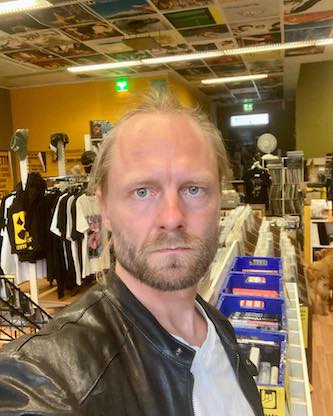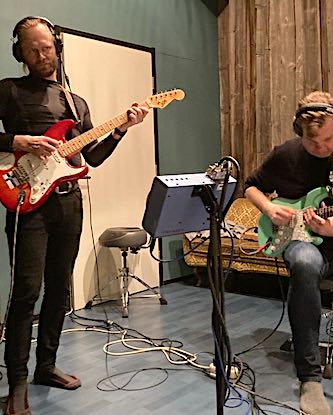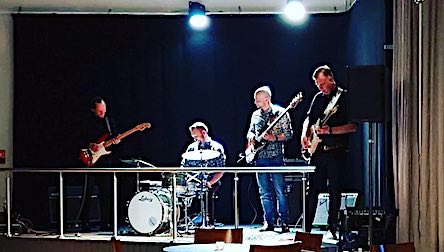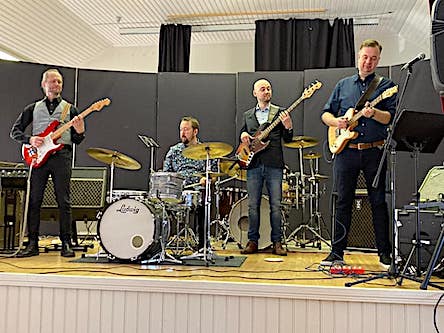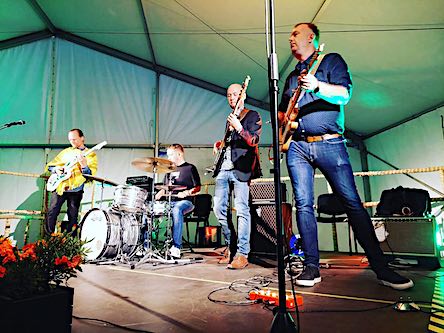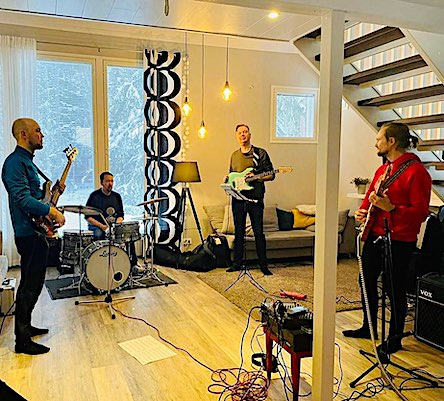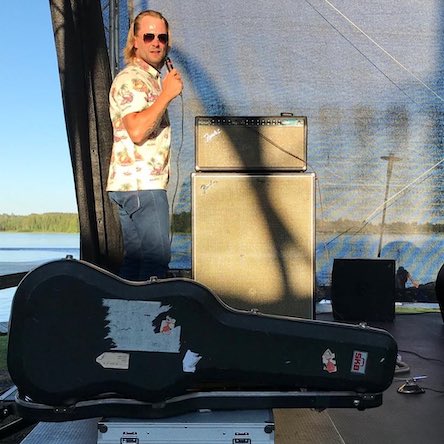|
|
||||
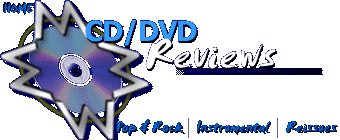 
|
||||
|
|
ELDANKA |
|||
|
For the better part of the past half century, Finland has remained a central focus of instrumental rock music fans. Perhaps, it’s the severity of their long, dark winters or perhaps their illustrious legacy of brilliant composers—from Jean Sibelius to the late, great Finnish rock instrumental composer Pekka Pohjola. Even in times of global chaos, pandemics and war, the Finns can be counted on to transform the art of instrumental rock and take it to the next logical progression. Pekka Pohjola did the same thing for his Finnish jazz fusion throughout the 1970s and ‘80s and, bringing Finland’s innate sense of continental, instrumental rock virtuosity to the forefront in the early 21st century is Eldanka. Musically, highlights abound; from the Spanish-tinged Mariachi groove of “Descanso” to the Spy-Surf blast of the title track “Joldanka Patrol”, to the memorable Finnish flair of tracks such as “Cosy Mementos” and “Necropolis Sidewalk” to the Sci-fi flavors of “Le Parc” to the classical surf-rock of “The Bog" (Cantus Articus), there’s hardly a note out of place. Fans of surf-rock will love the album's cover art with its humorous surf-rock setting. On Joldanka Patrol, Eldanka features the same line-up of musicians that played on 2018’s Rusty Treasures album, including the band’s primary composer Mika Jämsä (lead guitar), Rasmus Tammik (rhythm guitar), Mauri Haapamäki (bass guitar) and Janne Torvikoski (drums). Although most of the tracks are Eldanka originals written by Mika Jämsä, the two covers here include a daring version of a track from the 1986 Tangerine Dream album Le Parc, entitled “L.A. Streethawk” and a cover, done surf-rock style, from the pen of Finnish classical composer Einojuhani Rautavaara called “The Bog”, taken from his elongated composition, “Cantus Articus”. One of the best instrumental rock bands ever to come out of Finland, Eldanka takes the ‘surf-rock’ idiom to the next logical step forward for the modern-era guitar instrumental genre originally pioneered by giants like Hank Marvin and Duane Eddy. Music fans lucky enough to have heard the first two Eldanka albums—Twangin’ Tritones and Rusty Treasures—will find much to like about Joldanka Patrol.
mwe3.com presents a new interview with
MJ: In Finland, we are rising from the pandemic due to the fact that the cultural sector was the biggest sufferer. Man, you would think we’d have extra time to make music and recordings, but instead of working we rather became restricted and depressed. After that, our neighbor country, with an idiotic despot, attacked Ukraine. We choose a different runway and joined NATO and immediately we feel safer now. It’s been a big shame for the relationship and co-operation with music and the cultural people for a long time. mwe3: I remember you told me about the origins of the name Eldanka and how you tied it to previous battles between Russia and Finland and you said Joldanka lakes translates into Eldanka in Finnish language. I guess the war, so close between Russia and Ukraine, has affected Finland a lot. So it’s good timing? Is there a connection in the title track “Joldanka Patrol”? Do you personally have an interest or other thoughts about the war there and how dangerous is it in fighting Russia? It hurts my eyes to see Finland caught up in it. I remember one of my Finnish music heroes, Jim Pembroke, wrote a song almost 50 years ago called “Nuclear Nightclub”. Jim was no doubt worried then too and then in 1981 he wrote a song called “The Nuclear Dustman’s Ball”. I guess the Finns have long lived with that nuclear specter hanging over them. You mention about the song “Joldanka Patrol” that there are balalaikas in the song. A mix of James Bond intrigue and Slavic melodies? How did you play the balalaikas or at least get the effect of the sound? “From Russia With Love”… anyone? MJ: We are safe and not at all afraid, but we feel anger towards Russian terror and we have empathy and feel the great misery of the Ukrainian people. Eldanka and I have played in several of Ukraine’s support concerts during the year. Finland has over 1300 kilometers common border with Russia and we were an independent part of Russia over a hundred years ago, during the 1800’s. That history resounds, of course, in our music, and the material was done before the war. The balalaika parts in title tune are a breeze of common history and are actually guitars played with a Balalaika tremolo technique. This tune was made before the war – nowadays that kindly nostalgia has changed to disgust. If we take this James Bond situation or position, times of cold war have come back. mwe3: What was going on with the band between Rusty Treasures in 2018 and Joldanka Patrol in 2022 now into 2023? I imagine Europe went from a global pandemic into a war, that’s a lot to go through but you managed to record your finest album yet with Joldanka Patrol. How did everything that has transpired affect you and Eldanka musically? I guess it was a good time to write music as is now evidenced by the new album.
mwe3: There’s an endless array of classic songs on Joldanka Patrol. I really think Pekka Pohjola would have liked the new Eldanka album a lot. Pekka told me in my interview with him that his first band was called “The Boys”, which I thought was named after the Shadows song “The Boys”. What was your mindset in writing the songs on this latest album and did most of them come together around the same time or were some written earlier? Did you have a prolific writing period? MJ: By the way, The Boys are the oldest Finnish rock band and are still working behind an original founder Jussi Raittinen. It’s said The Boys is a Finnish University of Rock ’n’ Roll – so many of our great musicians have played in the band in the past seven decades. Jussi is a Finnish legend and he was singing with us on our latest album release. He started his career with ”Rautalanka” and has made legendary tracks with his first band Esquires. The Shadows were one of their biggest influences. We finished the recordings of the Rusty Treasures in 2017, and quite soon after that I had a full dozen of new pieces ready for the next album. They have been ready for recording for years, but it became essential that our recordings will take time. Monkey business is an obstacle to me for making new material. I can’t make new ones before recording the completed stuff on an album. In the Spring of 2019 I played these pieces alone, then Covid shut the society, while hoping we could at least keep the rehearsals. Then I suddenly cut my left hand finger by carrying heavy duckboards and thought I could never play guitar. That was a shock and I couldn’t play guitar for three months at all. Anyway, when I recovered, I hastened the project and became determined again about finishing the recordings. mwe3: The leadoff album track “Descanso” has a Spanish flair to it. Was this track partly inspired by your classical guitar background? Last time we spoke you mentioned your affinity for Spanish and Latin American composers and you have featured some Spanish sounding motifs in your music before. So, is it fair to assume “Descanso” is a perfect vehicle for your love of the legendary Spanish classical music composers, albeit from a guitar instrumental perspective?
mwe3: You also spoke earlier about practicing classical guitar for many years yet, do you still use a pick for your right hand technique? What do you like best about classical technique for plucking out notes versus picking with a plectrum? Do you still play classical guitar and would you ever use a classical nylon string guitar on an Eldanka album? There are some great classical guitarists in Finland I believe, so do you still listen to classical guitarists from Finland and beyond and who is your favorite classical guitarist and classical composer? MJ: My favorite Finnish classical guitarist is Timo Korhonen and I like his album Manuel Ponce (Mexican) works for classical guitar (1991). He’s was also my teacher during my childhood. I have periods when I take my classical guitar and play the old repertoire. That is great calisthenics for the left hand fingers. On this album we decided not to take any extra instruments, avoiding a jumble and feeling more like live playing. Usually, classical music has very huge impact on my music. mwe3: The track “Dance Of The Earworm” is a spunky little tune. It again has a kind of Spanish tinge yet it’s also got a Finnish edge as well and possibly a Shadows sound too. But you say it is Mexican flavored with the subject being that drink Mezcal. Have you tried that drink? Seems rather strong if they can feature a pickled worm in in the bottle! Tell us about the melody of that song and how you worked out the arrangement with the other members of Eldanka. For example, are there 2 lead electric guitars on that song or are you overdubbing parts? Were there any overdubs on Joldanka Patrol or was it all recorded live in the studio? MJ: I think this tune is a good example of our style to arrange music for four players. That irritating theme and arrangement is full of those Latin American surf influences. The Scottish whiskey is the strongest booze I rarely use but If we’d ever get to tour in Mexico, of course I’d taste a Mezcal and of course with a worm. For this album, we played, incidentally, everything live and there’s no doublings. When the rhythm guitar disengages to play the harmony part there’s no accompaniment. That sounds airy. One piece, “The Outlander”, we decided to use acoustic rhythm guitar and double that. I think that’s a necessary change and is reminiscent of the 1960’s Shadows style. By recording to tape we don’t need to record excessive doubling tracks. The guitars are also panned to different speakers like on our live gigs.
MJ: Heh, you’re right. In a verse, there’s a spy theme in four different keys – like a four member partisan patrol. Then rising tension towards the chorus in a Slavic minor key with those balalaika guitars at the end, and at the start. I like the music of Laika & The Cosmonauts, but compared to their music, I think Finnish Rautalanka with Slavic melodies are more distinct in our music. I should be careful comparing us to the masters… apologies. mwe3: “Cesium 137” is an interesting name for a track. Tell us about the song title name and do you think it’s more of a traditional kind of surf-flavored track, although there is hardly anything traditional about Eldanka, and if anything you stand tradition on its head. Yet, it’s another action-packed track. Tell us about the Ukrainian connection on “Cesium 137”. I didn’t realize the Chernobyl meltdown impacted people in Finland too. You were very young at that time right? I remember being scared of that radiation blast too. MJ: I was nine years old when Chernobyl exploded and the fallout reached Finland also, despite that the Soviet Union didn’t admit the explosion or any ”special operation” for several days. I was annoyed because my delicacy, the liver sausage, was not possible to eat because of the nuclear pollution. Also, berries had to be left in the forest for years. A couple of years ago there was a great American-British TV-series about Chernobyl which gave a subject to this piece of music. It was grotesque that the Russians nearly caused a new disaster by capturing the closed power plant. mwe3: With its stately melody, “Country For Good Men” is sure to spark interest in Eldanka, even among newcomers too. It really ranges from country music, to Finnish music to a kind of Duane Eddy widescreen guitar sound. Does the track hint at reincarnation or perhaps, it’s another kind of Finnish sounding patriotic anthem of sorts to try and cheer people up in times of hardships? Tell us about the guitar sounds and various effects that you use on the track. The guitar has a kind of “Leslie” cabinet effect, which is one of my favorite guitar sounds. MJ: There’s “No Country for Old Men”, which is one of Coen’s brothers’ movie. A couple of years ago, too many close people passed away, including my grandfather. I composed this slow tune to honor them. I realized afterwards there’s a ‘Stairway To Heaven’ chord progression in the chorus. One of our fans got our vinyl from the post on the same day that his father past away. I gave him this comforting story. I had to play the whole song with an old Dynacord Leslie cabinet with slower and faster functions but there was some failure in the switch and I used it only in the last chorus. But the creaking mechanical noises sounds along the whole piece which we like a lot.
MJ: Yeah, you should know there appeared a silver monolith in Utah, in the San Juan prairie due the foreigners from outer space, like in 2001: A Space Odyssey. The race of the wonderers gave a name to this galloping tune. That had an impact everywhere in the world. Aliens built monoliths, even here in Finland. There’s also a copy of Utah’s monolith in the back cover of our album. We’re very lucky someone got a photo before it was stolen. In fact, this tune was so traditional and antiquated it didn’t have to be on the album at all. I thought I would offer this somewhat more traditional Rautalanka band on the recording as an original tune. There’s certainly a Shadows pastiche with a little, clumsy, improvisational B-part. And second fact – the name. We discussed, with my wife, about an American-British series called ”Outlander” from the TV, where a woman accidentally made a time trip to 1800’s Scotland during a civil war. That time was a highlight of my smokey whisky consumption. mwe3: “Cosy Mementos” also has an early 1960s Shadows sound to it. Yet it’s also upbeat and has some great breaks and chord changes. Is that track the perfect vehicle to channel your inner Hank guitar sound? Is there also a Spanish classical vibe in certain parts, with double stops and even pizzicato style plectrum work. How would you describe your guitar approach on “Cosy Mementos”? MJ: We were doing an Eldanka cover version of a local accordion waltz called ”Cosy Memories”. In Finland, many Rautalanka tunes from 1960’s were originally waltzes but played in four with a rapid twist beat and a walking bass. We made our demo recording of that waltz but it didn’t work out so I thought it would be better to create a new one. I used the same name honoring the composer’s lifework. I invented a pretty intro to that piece and the composed solo part is an accordion style fast scale passage combined with twangy parts. Accordion virtuoso music is typically full of notes. That song presents our traditional roots in many ways. I have to confess that I have also seriously played the accordion and still love the sound. The most popular Finnish dance orchestras prefer both lines in their repertoires – Rautalanka and accordion schlagers. And it’s remarkable there are not so many songs in a major key on the album.
How influenced were you by T.Dream, Jarre, Kraftwerk, etc? I was pretty surprised to find in the early 1980s how influenced the Shadows were by electronic music composers like Jarre. Is Le Parc your favorite T.Dream album and would you consider more covers in this realm? MJ: During my sensitive childhood age in the 1980’s there was two American action TV-series above all: “Knight Rider” and “Streethawk”. Le Parc was a main theme of “Streethawk”, where ex-cops caught bad guys by motorcycle. These synthesizer themes, including Jarre’s “Oxygen” were a part of the soundtrack to my childhood. When I rediscovered this “Streethawk” TV-intro I immediately had to arrange it as a surf-rock version. Later I found Tangerine Dream, Krautrock and ambient music because of my colleague Juha-Matti, who also appears on our album with his modular synthesizer. The last piece from our second album, “Springfields”, had a notable ambient part. TV and movie themes have been an essential ingredient for instro bands, but we had to find those less decrepit ones – like “Das Boot” on our first album! That was also a German synthesizer tune from 1980’s. mwe3: Does “Necropolis Sidewalk” hark back to a darker Finnish music sound? For some reason, I was thinking that Pekka Pohjola would like this track as well. Does it have a kind of Pohjola-esque vibe to it? Perhaps, in the way it is firmly controlled and directed and also the “rolling drums”. In other words, it builds and then has a very powerful outcome as it unfolds with different chord changes. Perhaps it's not played in the prog style but perhaps the melodic lines? At least to my ears but I am very sensitive to tracks with this much depth. Pekka also had a great sense of humor and even the title has a very stark sense of humor. I remember being in Helsinki during the summer of 1979, and going into the bar of my hotel and asking the DJ to play my cassette with various tracks I compiled of Pekka’s music. Pekka had recently released his 1978 album with “The Group” and while it was playing, some drunk guy started yelling out loud, “take off this funeral music”! I never forgot that moment. I didn’t know the word Necropolis is a synonym for a cemetery. It’s endemic to Finnish music to have this much dark / contrasting melodic information. MJ: In Finland we always celebrate in the minor key. Regarding your experience I must say people here are outspoken only when their drunk. I have to get back to the fellow who first praised our band but later in the evening said ”your music is not Rautalanka because of changes in the comping”. Your right... the humor is hidden deeply in our music, but maybe this is our most serious tune with a mystical atmosphere. As a music history teacher, I’ve been interested in the music from the lost ancient cultures and this one represents exoticism again. mwe3: “The Bog” also has a sense of humor yet it’s a based on a traditional Finnish work by Einojuhani Rautavaara. Tell us how and why you chose “Cantus Articus” to turn into a modern day surf-rock instrumental. Can you mention a link on you tube or elsewhere that demonstrates some of Rautavaara’s melodies you featured on Eldanka's version of “The Bog”? In its original form, it’s a rather long piece of music right? Finnish classical music meets The Ventures?
When you listen to the flute theme that comes out as a blues scale and is an obviously palm muted surf guitar intro to the song. The main cello theme is imposing with greatness and wants to be played by Rautalanka guitar. Echoing the original work, I let my tape recorder scream imitating the original birds on tape. The composer himself has recorded Finnish migrant birds in the swamp. When the piece is performed live with an orchestra, the original recording, a copy of course, is used everywhere. The spring and fall are crucial times of the year in Finland not the least because of the moving masses of birds. There’s a good recording at Spotify And there you can follow the score in YouTube mwe3: “Nostalgia” might be one of my favorites on Joldanka Patrol. That’s another Pohjola-esque track in my estimation. Sorry to harp on those “instrospective” aspects. I guess it’s been too long since Pekka has been gone. Especially, on the second half of the track when it goes into full flight mode. Also the Shadows influence is quite apparent on this track. You mentioned it brings back memories of your childhood times. MJ: That’s a composition by our bass player Mauri. Although he works as a Silversmith, he’s musically talented. As a very sensitive person, he goes deeper than anyone else of us. In this not-so-obvious surf rock melody the ”Hank Marvin” sound is a connection to the genre. I asked Mauri what this piece represents and he said that’s a state of mind; someone – senior, sailor, surfer, smith, musician – remembering the good old times and a lived life. Well… I think we still are at the best age and not geriatric in spite of this beautiful song. mwe3: “A Message From Alderaan” is a great way to close the Joldanka Patrol album. You mention how Alderaan was a planet in the Star Wars movies but Eldanka took it a step further. How did you get the Sci-fi sound effects in the song? It’s a very pensive way to close the album, sort of like adding a bookmark, a kind of sonic suspension, that feels like a ‘to be continued’ moment in some way.
The first time I saw Star Wars I had to watch that from the door chink of our children’s room. The sound effects and especially the R2-D2 was miraculous and that movie was all I watched for several months. My friend Juha-Matti, in addition to his bass guitar ambient music, also creates music with his modular synthesizers. I begged him to create this soundscape to this song and he hit the bulls-eye. This song is a message from a planet in another galaxy and no one can deny that fact. The most valuable comment so far has been ”what the fuck is this”? I appreciate that kind of high-quality deliberation. mwe3: Tell us about the recordings and production and how did working with the producer impact the overall sound of Joldanka Patrol? The CD has a warm sound for a surf-rock album. MJ: I have been very unsatisfied with the sound and methods of digital recording and streaming music for free in digital platforms. That is a concern when it comes to our own doings and we had to find another way. We found the great Astia-studio and co-producer Anssi Kippo to make a full analog signal path recording. Anssi has made a historical recording with Finnish metal spearhead and our pride, Children Of Bodom, and he’s also very familiar with older music and recording methods of past years. So we decided to play the whole album live, directly to the tape with no digital equipment or editing at all. Only signal limiting was used a little bit in the bass guitar and there’s an extra room vintage effects in the drums. The album was played, recorded, mixed and mastered with no digital paths. The vinyl was pressed from the original master tape. Nowadays, vinyl albums, including rereleases are almost without exception pressed from a digital file, losing the connection to analog. We were pedantic about preserving the analog signal path. This method has produced a sympathetic, pure and honest sound and co-playing we can stand behind. Essentially, this was a trip into the deepest essence of playing and creating music together. It’s said that recording music for the first time in Astia-studio is like the first grade of music school. I recommend that from the bottom of my heart to everyone. Almost everyone has to change to make a C-cassette recording with a very constricted amount of equipment – especially digital equipment. You will probably find the happiness and genuineness that you don’t get from digital recordings.
MJ: We got an excellent graphic artist to design the artwork. I told him about the main issues of the music and he ingeniously included them in the album cover art. We hoped he would create a fresh connection to the surf music genre. You can find there the motorcycle of Streethawk, the silver monolith at the Necropolis and everything else… The great black woodpecker is a monumental symbol of the Finnish national romantic period painting art by Akseli Gallen-Kallela. Looks like it’s totally lost and in the wrong place! mwe3: What else are you looking forward to in 2023? With so much gloom and doom in the air, how do you stay upbeat and resourceful and what else interests you musically these days? MJ: We have some gigs, but the stones have to keep on rolling. It’s expensive to produce physical albums, but we just can’t give them for free on the digital platforms. Luckily, the customers of our genre are still buying physical records.
We guitarists have also a side project, Tres Nachos, which is my approach to original twangy folk pieces. We have a full album of pieces just waiting for the right time to produce them on a recording. And of course – we’re doing a live tape recording. Until that I have to learn how to play guitar…
|
|
|||
|
||||

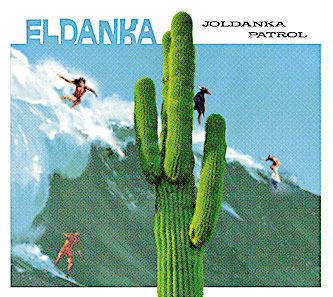 The 2019 CD entitled Rusty Treasures, the second album by Finnish instrumental rockers Eldanka, was such a masterpiece of vintage, yet completely contemporary sounding guitar instrumentals, that in the months that followed I imagined, how on earth would these gifted Finns be able to top it? Suffice to say that after several years of global chaos and then a war at the doorstep of their Finnish homeland, Eldanka are back with an album, entitled Joldanka Patrol, that is clearly equal to if not necessarily better than the aforementioned Rusty Treasures. A splendid sounding follow-up album, Joldanka Patrol is a nevertheless a contiguous step forward for Eldanka and the entire European guitar idiom.
The 2019 CD entitled Rusty Treasures, the second album by Finnish instrumental rockers Eldanka, was such a masterpiece of vintage, yet completely contemporary sounding guitar instrumentals, that in the months that followed I imagined, how on earth would these gifted Finns be able to top it? Suffice to say that after several years of global chaos and then a war at the doorstep of their Finnish homeland, Eldanka are back with an album, entitled Joldanka Patrol, that is clearly equal to if not necessarily better than the aforementioned Rusty Treasures. A splendid sounding follow-up album, Joldanka Patrol is a nevertheless a contiguous step forward for Eldanka and the entire European guitar idiom.